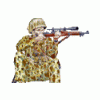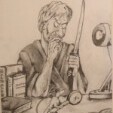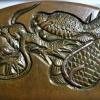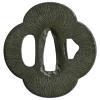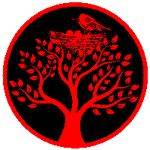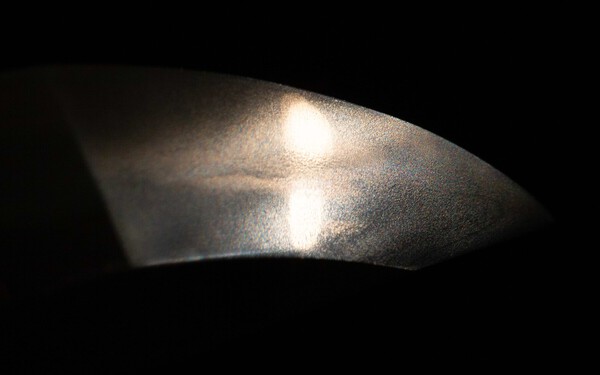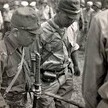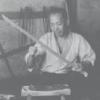Leaderboard
Popular Content
Showing content with the highest reputation on 06/12/2021 in Posts
-
11 points
-
Ok so I am not sure what to say. I must admit on my screen I didn't see the mei when I posted it up so my apologies for being lax. However isn't the idea of this to look at the shape and features of the blade read the description and try and assess who the blade was made and when? So now you have read the mei what has been learned from the exercise? The next question is which Tadayoshi made it? you have 9 generations to choose from Fortunately the the date isn't cut on the nakago. Again my apologies for the initial error it isn't one that will be repeated.3 points
-
Thinking about it Jon, i did have one small issue but it was resolved quickly. Bought a sword and it turned up with some rust spots in the Bo-hi (groove), they accepted it back but shipping it back took some time and was a bit of a worry (as shipping swords ALWAYS is). I didnt study the images online as closely as i should have done. There is no rush to buy a sword, hang around for a bit and get to know what you like first. No point buying something then wishing you hadn't, as a lot of folk do when they become interested in these swords. You see some fair deals on Aoi, sometimes great deals though in the sales section below. Usually, new folk have to have the "katana", but tanto or waks can be a better option. Lets face it, you dont need a 70cm blade for study and they can be pretty cumbersome. Shipping is more awkward and then you get the likes of customs and couriers being a little more curious, maybe All depends where you shop, i am but an humble bottom dweller happy with stuff like this Tanto: Kanekishi | Japanese Sword Shop Aoi-Art (aoijapan.com) Nota recommendation, just personal preference and making the point that it does not need to be so expensive. No papers, no need, good saving. Nice signed blade, nice fittings., small, easily studied, easily shipped, happy days. Have fun!3 points
-
Dear all following the popularity of the recent kantei posted by Chris I have added another one below. Unfortunately my photographic skills aren't up to the standard seen in Chris' example so i have added a detailed description as well. Normally kantei blades should be a typical example of a school or smiths work. In this case there are many of the features you might expect to see but it isn't altogether typical. The sword: Shinogi-Zukuri, iori mune with tori-sori. Suriage with nijimei Nagasa 48.4cm Sori 0.9cm Motohaba 2.8cm Sakihaba 1.9cm Kasane 0.6cm Sugata: The blade was originally 6-8cm longer than its current nagasa. Despite being shortened it retains elegant proportion. The blade narrows elegantly from the machi to kissaki. The shinogi is of medium height with a fairly wide shinogi-ji. There are 3 small kirikomi visible on the shinogi, one on the ura and two on the omote. Hada: The hada is a very fine and consistent ko-itame. Overall the blade has a great deal of ji-nie which becomes brighter and larger as it progresses to the monouchi. There are also small chickei running the length of the blade. The quality of the forging and the brightness of the nie based activity are outstanding. Hamon: The hamon is a very gentle midare based on a suguha foundation. The nioi-guchi is extremely clear and bright and has a characteristic “belt like” form associated with this school. Running throughout the hamon is a great deal of activity comprising of very bright nie which cascades through the nioi-guchi and creates clouds of nie on the border with the ji. There is kinsuji in the lower half of the blade. As it progresses towards the monouchi the nie becomes larger and brighter in areas it forms nijuba and kuichigai-ba. Kissaki: The blade has a slightly small chu-kissaki with suguha boshi which is ko-maru with a short kaeri. Nakago: The Nakago is suriage with 3 mekugi-ana. There is a nijimei on the lower part of the blade and the original yasurime are clearly distinguishable. The yasurime are very slightly katte-sagari2 points
-
sorry Jon I don't know I am aware of them by word of mouth. BTW it isn't a specific sword fair it is a traditional arms & militaria fair but most UK dealers are (were) there.2 points
-
The most popular shows of recent years have been the Birmingham show held at the Motor cycle museum and the London show (not sure of latest venue) Birmingham has been well attended in the past but maybe gone off a little in recent years. It will be interesting to see what happens when they restart. If you want to see blades in hand I suggest you consider joining the Token of GB. We hold regional meetings for members (once restrictions are lifted.) and there are always blades to study and experienced people to talk to.2 points
-
Attribution to the supposed maker. He was known for his renderings of animals, crabs, etc.. I have a nice kozuka by him that is a homage to Yasuchika and signed as such. I've owned a tsuba or two by him. The attribution is spurious, or at least I am fairly sure the NBTHK wouldn't paper it that way unless there is a signature somewhere.2 points
-
2 points
-
Hello everyone-- I did a brief review of this book in another thread 9 days ago. Reposting it here: I received the “Sho-shin Index of Swordsmiths & Price Guide”yesterday. This is the first volume of Robert Cole’s long awaited book series on Japanese sword appraisal. This is a handy reference handbook for Nihonto collectors. It is not a picture book with pretty pictures of Japanese swords and beginner’s information on Nihonto. If you do not own at least the intermediate level references Toko Jiten by Fujishiro and the Toko Taikan by Tokuno, then this reference is not going to point you to any comparative oshigata or signatures of swordsmiths. The primary component of the book is 76 pages of single line listings of swordsmiths by name and kanji, along with 9 columns of useful information. This information includes the smith’s generation (if needed), working era, province, and page numbers if listed in the Toko Taikan, the Toko Jiten, and Hawley’s. Also listed is a rating of the smith using Fujishiro’s Chu-saku through Saijo-saku ranking system. Of use for comparative pricing is the column listing Tokuno’s “Man-yen” rating for the swordsmiths listed. There is a helpful section in the book listing swordsmiths by title; there are 49 smiths listed that had the Izumi-no-kami title and only 4 that had Totomi-no-kami for example. The titles are written both in Romaji and kanji. There are two listings of Nengo; one alphabetically (Romaji) and the other chronologically with kanji. One interesting listing I don’t recall having seen before is an alphabetical listing in Romaji for a spoken word, such as “Nori,” and the kanji that are associated with it. Apparently there are 9 kanji that can be used for Nori. Who knew? There is a Nihonto glossary and some other handy things in this book, but the author’s primary focus was on listing the swordsmiths’ data. If you want quick access to the information available in this book, you will find it very useful. If you are just beginning to learn about Japanese swords, then this book is definitely not for you. Bob Gilmore2 points
-
Komonjo sells real and fake stuff. He is a serious case of "caveat emptor." You can find some real nice stuff from him rarely, but you can also lose your shirt trying to do so. He has no scruples with selling whatever comes his way. However, he is fine with taking returns. I dealt with him once and he made that very clear that he'd do returns if I were unhappy. This is not me giving my approval for what he sells though. If you buy from him, be aware of what you're looking at.2 points
-
I had resisted the urge to add further to this discussion. Modified Japanese bayonets are anything but rare, but I had never seen what looked to me like a Japanese style modification so I thought it might be a worthy addition to our assembled understanding of WWII era cutlery. The world was awash in Arisaka bayonets as the War wound down and this sorry weapons suggested to me that bored American lads were NOT the only ones exploring ways of using them. Could this have been made as a homeland defensive weapon – up there with pointed bamboo sticks? We’ll never know, I suppose. But then this discussion took a turn toward character assessment of the seller. I do not know Komonjo-sama. And I certainly don’t know anything about the other purveyors that sell stuff on eBay. But with sincerity – and even respect -, I think that modern sword collectors ought to look closely – and even positively – at Komonjo-sama’s wares. It looks to me like he has dependable access to (among other things) real and true Japanese junk. Japanese society is well organized, in swords and everything else. When blades surface in Japan, they are assessed, judged, and moved to the right market. It looks to me like Komonjo-sama gets ahold of stuff that has surfaced and been assessed AND cannot find a market in Japan. The Japanese antiques system has figured out that in Japan this is scrap iron. Discard it…, ahh, BUT wait! Greedy, naïve, or optimistic Americans seem willing and able to buy it. Hence, Komonjo – his prices are low and his descriptions seem all right. He makes no bones about it. Anyone who would buy Komonjo-sama’s low end stuff assuming that it is ‘good’ is either a gambler, or foolish. BUT somebody IS buying his blades. Once those blades get to the New World, they will show up in auctions and gun shows and the next generation of emergent collectors will not know their history, but will have heard the stories of “barn finds.” Bargain hunters will buy them, “clean them up” (OMG!) and very likely come to the NMB to “ask advice.” Peter2 points
-
1 point
-
ummmm no. my idea when starting this thread, was so that new collecters can learn from and aspire to own and preserve the better then average gunto. sadly due to the market levels the "averge" gunto now being lookied apon as being special or rare, which i disagree with. sorry that migh sound like me on a soup box. If the idea of low class gunto section was to be born it most likey will be filled with crap you can already see on "fleabay" or heavan forbid the obvious fakes that some members cling to in hope that they are genuine, being put in. thus distorting the line between of what genuine and wahts fact for the new collector.1 point
-
1 point
-
In hindsight I should have sent a PM, my sincere apologies Paul. The Mei is slightly different, but I will go with 4th gen.1 point
-
Brian, I was never close enough to "collecting" in Japan to be anything like an expert. I never had any money. But I do realize that there are laws and regulations that are supposed to guide handling of - ahhh - weapons. I also assume that there are ways of avoiding regulations and "flying below the radar." I would really and truly like to know how the stuff Komonjo-sama presents gets to the US, but certainly, once it is "here" it is "legal." Have people asked him? Please help me "study" this matter further. Maybe I'll write another novel.... Peter1 point
-
I heard that the next show was to be on the 20th June but as that is a day before 'open season' it can't be held so I assume it to be 3/4 months later1 point
-
I do not think fitters would risk damaging a sword by stamping. Unless they owned the blade and were going to sell privately. But we have seen many blades with paint. Plus the stamps on fittings only and those without, the mystery continues....1 point
-
Geoff, I haven't seen the one in question, but the answer is that, while not common, RS can be found with only 1 mekugi ana. No officially known reason for that. I personally think the blades in them were made with Type 98 (or civil) mounts in mind, but the buyer/sword shop decided they wanted it in RS fittings. War damage leading to re-fittings could explain some too.1 point
-
Mine is blade no. 4177 with no screw. Saya no. 1530 -------- In the case of that FB sword. I had the guess that sword had no screw first and was later added? It is made very professional and you see no differences in the patination with niage of the copper.1 point
-
Hi Jon, I haven't bought from them recently but the importation process went smoothly, I think on three occasions, and I had no issues in terms of how the items were described in the paperwork and import tax paid. I once had to chase them over a tracking number once as there was a typo in the one they gave me but this was dealt with quickly and was easily resolved. Like Alex, I had an issue over the condition of a blade: because they scan images of their swords they have to photoshop in what is effectively a generic mune and one that I bought had a muneware that didn't show in the picture. Unfortunately, I was less than eagle-eyed and it was very fine so I didn't notice it until some time later and I didn't feel I could raise the issue with them so I'm partially at fault, but I did feel somewhat disappointed that it hadn't been mentioned in the sales blurb as it wasn't something I could see and take a view on in the pictures. They are normally pretty good at highlighting the big stuff though i.e. fatal flaws like hagiri or issues with signatures. Like Alex says, size isn't everything and take your time - there's no shortage of swords and the right one will come up before long.1 point
-
Half of a Mei? Can't see any hamon in the blade, and it looks acid etched. Are you wanting to buy this? Would being cobbled up in Japan raise its desirability over a China job?1 point
-
The Dou, all alterations aside is actually quite interesting, a relatively uncommon form, these Dou are essentially munition/Okashi grade items. The reason it is signed is because the Iwai were often tasked with and responsible for repairing and refurbishing Okashi armour in the Edo period, this is also why there are so many examples of mediocre armour bearing the Iwai inscriptions. Below is an example of similar style of Dou, and another that has an Iwai inscription that sold recently on yahoo. These examples are more indicative of what the Dou originally would have looked like.1 point
-
Steve, this sword in question is in fairly uncommon mounts. Being late war, the fittings are very basic, pressed metal, with no detail. If the blade is in good condition, it is a very collectable sword. I would also suggest that your posts are more appropriate to be posted in the MILITARY section.1 point
-
No, because you just don't see many of this last-stage version of the Rinji seishiki.1 point
-
Agreed, he's not in the same category as The Monkey. I've chatted a little with him too, and a good deal of his stuff, or some of it, he sells on consignment. My only complaint of his business practice is that he seems willing to sell anything, even if it's been faked by his supplier. But I've read that much of what he sells is legit, but like Peter said, maybe lower-end stuff. It's like all buying - Buyer Beware - know what you're getting before you get it.1 point
-
1 point
-
Heianjo. Onin tend to be better work. More close to katchushi work. Heianjo tend to be flashier, but the iron usually a little bit cruder. Hence the marked price difference between Onin and Heianjo in Japan. Onin are not always better. There are some low end ones and ones where the tsuba has taken quite a beating. And sometimes a Heianjo will be off awesome design and workmanship.1 point
-
Yes it is authentic, the handle was very poorly re-wrapped at some point. You'll want to factor in a professional re-wrap into the price.1 point
-
1 point
-
1 point
-
1 point
-
Shinto Ishido my guess. Also i think there was a yokoyama gimei removed but this is pure speculation.1 point
-
Those were some pretty good answers. But then some kind of degenerated into the classic overthinking that can happen with kantei. Sucks when you were right or close then convince yourself that it's something else. Sometimes the gut feeling is the best one because it's being processed at a lower part of your brain, you feel that it looks like something and then you start going over too many checklists in your head and as mentioned, overthink. I never sold this sword, just worked on the photos. I had a chance to see it when Chris bought it from someone else. The Sadamune answers are very interesting to me because to me the hamon looks a lot like Takagi Sadamune. Also the Go and Tametsugu answers are interesting, because of the boshi... Go generally will not have an o-kissaki. So going to Tametsugu from there is not too bad. Less known is Tachibana Yoshizane ... another son/student of Go but nothing survived and so is a "really bad answer" for kantei. But when I look at a blade like this makes me think about a smith like that with lost work. Hata Nagayoshi, on the hada and nie is an interesting call but there are no mumei assigned to him, just 3 Norishige-like tanto with signatures. Esshu Kuniyuki makes this kind of standing out hada too. The Sa Sadayoshi call though if you look at the other Sadayoshi, is very good and relevant. There are a lot of O-kissaki blades with bright nie and vivid hada in the group of Samonji students and they are all very highly ranked. Here is another and you can see the similarities in hamon structure and blade shape. And if you have seen something like the following you can go right into the Sa group. I would have said Takagi Sadamune as my answer if I didn't know what it was already. But when you look at the other examples the rationale is very clear as to the attribution.1 point
-
Over on Japanese Militaria our resident native Japanese contributor is adamant that this is not a good idea. He compares it to contacting a German family and offering to return a case of SS marked grenades that their Granddad had left behind. On another note, the family would also need to pay for a sword license in order to keep it. Other more personal relics like Hinomaru, Senninbari and Yosegaki are another matter, and are often welcomed as giving closure on a lost family member.1 point
-
1 point
-
Where is the "Show us your Low-class Gunto" thread? That could be interesting! Lol0 points
-
Did you hear that Stephen? A branch of the navy, meaning we're the big dog in that fight0 points

